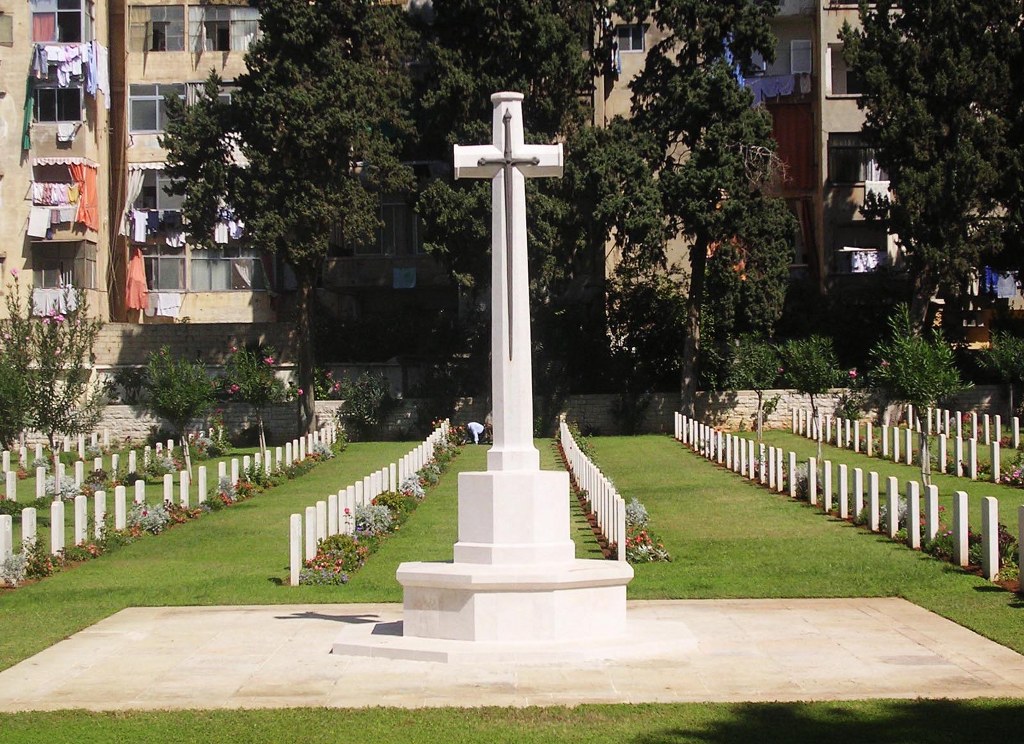Beirut War Cemetery
- Country Lebanese Republic
- Total identified casualties 1180 Find these casualties
- Identified casualties from First & Second World War
- GPS Coordinates Latitude: 33.86945, Longitude: 35.50521
Historical Note
 Indian and Egyptian casualties at Beirut (Saida Road) Cemetery were originally commemorated at this site by a nameless memorial with their names added to a cemetery register. In 1996, their names were added to the memorial.
Indian and Egyptian casualties at Beirut (Saida Road) Cemetery were originally commemorated at this site by a nameless memorial with their names added to a cemetery register. In 1996, their names were added to the memorial.
You can find more information about historical inequalities in commemoration in our Special Committee’s report.
Keep your ear to the ground

Beirut WAR CEMETERY
Location: Beirut, Lebanon Language: Arabic Altitude: 33m
Temperature: 10°c - 31°c Biggest challenge: Security / weather
Before going to work, the Commonwealth War Grave Commission’s Lebanese gardeners always switch on the local radio. Though the dry summers and spring flash floods cause them enough problems, they’re not listening to check the weather – they’re making sure it’s safe to go to work.
It’s a necessary precaution. Beirut has found itself the centre of attention for dangerous reasons in the past. There’s still political instability in neighbouring countries. A refugee centre near CWGC’s Beirut War Cemetery can at times be the focal point for tense stand-offs that spill out into the street.
Gardeners are on strict instructions to stay home at the slightest sign of trouble.
Thankfully, most days in Beirut begin peacefully enough. An early start before the sun’s punishing summer heat is normal for head gardener Yousef.

Archive image of Beirut War Cemetery after the First World War before the city grew around it.

The entrance to Beirut War Cemetery decorated with flags on Armistice Day in 1924.
Beirut War Cemetery’s grand date palms can only provide so much shade and the locally grown roses need constant attention to stay in bloom.
The war cemetery here is split into two parts: The First World War section is dominated by the graves of men who died of Spanish flu during the military occupation in 1918-19.
On the other side of the road, the Second World War part pays testament to the cost of the brutal fighting to reclaim the city from Vichy French and subsequent occupation.
And the World Wars weren’t the last time shots were fired here. During the complex Lebanese Civil War, it’s said the cemetery was used as an artillery position.
Throughout the 70s and 80s, the local gardeners did what they could despite repeated calls by the Commission not to put themselves at risk.

1982 photo showing the damage caused during the Lebanese Civil War.

On top of graffiti and vandalism, nearly 1,000 headstones were destroyed during the Lebanese Civil War.
One close call saw the head gardener forced to take cover behind a wall for an hour while sheltering from a bombardment.
By the time the civil war ended the number of headstones damaged by missiles and shell fire nearly reached 1,000. Luckily the damage was only superficial. The graves remained undisturbed and by 1994 the cemeteries were completely restored by the Commission.
Today, it’s the weather that causes the most problems. Flash spring floods and long, hot summers mean tending to flowers is a constant war against the elements, making that weather forecast on the radio important to pay attention to as well.

Despite the trying weather conditions, CWGC's local team manage to make these Europeana roses flourish.
Location information
This Cemetery is located on Jalloul, in the Assas Area which is to the west of the Forest of Pines.
The cemetery is next to a French cemetery and near to an electricity company and is divided into two seperate sections for First World War and Second World War burials, on opposite sides of the road.
GPS Co-ordinates: 33.869765, 35.505313
(or +33° 52' 11.15" N, +35° 30' 19.13" E)
Visiting information
The cemetery is open Monday to Friday 07:00 to 14:30 after which the gates are kept locked. If visitors wish to access the cemetery outside of these hours please contact the CWGC's Africa and Asia Area Office in advance via email: enquiries@cwgc.org
Wheelchair access is possible via the main entrance.
History information
Lebanon was taken from the Turks in 1918 by Commonwealth forces with small French and Arab detachments. Beirut was occupied by the 7th (Meerut) Division on 8 October 1918 when French warships were already in the harbour, and the 32nd and 15th Combined Clearing Hospitals were sent to the town.
In 1922 Syria and Lebanon became French mandated territory and after the fall of France in 1940, the two countries, under the control of the Vichy French, were a potential base for the Axis powers. The Germans infiltrated Syria in May 1941 posing a threat to the Suez Canal and the Allied positions in the Middle East. In an attempt to neutralise this threat, the Allies, including a contingent of Free French forces, advanced into both countries from Palestine on 8 June 1941. The campaign lasted until 11 July, when the Vichy French asked for an armistice. Subsequently the French Mandate was superseded by an agreement which made Lebanon an independent state from 1 January 1944.
Beirut War Cemetery is in two sections. One section, originally known as Beirut British War Cemetery, was begun in October 1918 and was later enlarged when graves were brought in from other burial grounds in the area. The older part of the adjoining section, originally known as Beirut (Saida Road) Indian and Egyptian Cemetery, contains three memorials to soldiers of the Indian army and the Egyptian Labour Corps who died during the First World War. This section was later extended for Second World War burials, and the two sections combined under the name of Beirut War Cemetery.
Commonwealth burials and commemorations at BEIRUT WAR CEMETERY now total 628 for the First World War and 531 for the Second World War. The cemetery also contains a number of war graves of other nationalities, many of them Greek and Turkish.
A further 251 Indian casualties of the Second World War are commemorated on the BEIRUT CREMATION MEMORIAL which stands within the cemetery.






